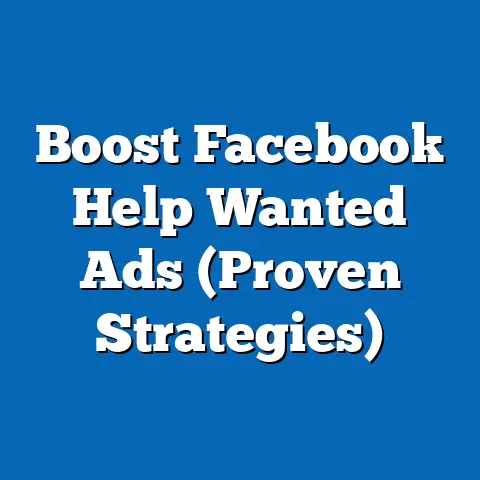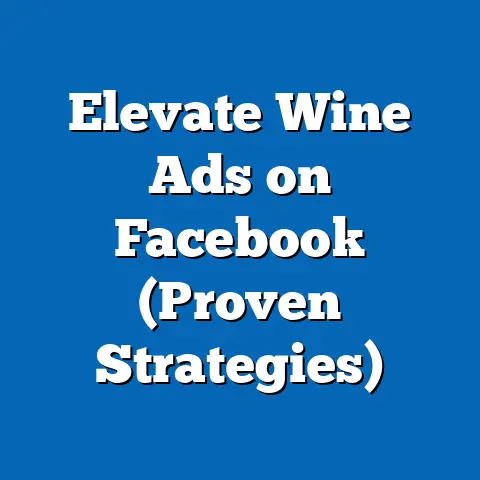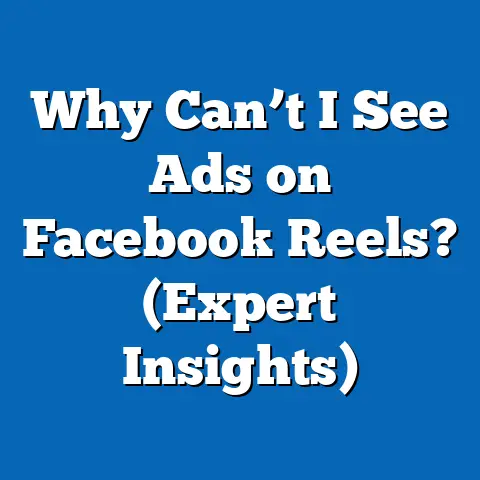Stop Facebook Ads Autoplay (Game-Changer for Engagement)
The autoplay feature on Facebook ads? Let’s be honest, it’s often more of an annoyance than an engagement driver. I’ve seen countless campaigns where the initial, uninvited video play leads to a quick scroll-past rather than a meaningful connection. It’s a frustrating reality for both marketers trying to reach their audience and users bombarded with unwanted content. Is it truly the best way to capture attention in today’s fast-paced digital world, or is it time we rethink how we present ads on social media platforms? I believe it’s the latter.
Autoplay, the automatic playing of video ads without user initiation, has become a ubiquitous feature on Facebook and other platforms. It’s designed to grab attention, but often it does so in a way that feels intrusive and disruptive. While the intention might be to increase visibility and engagement, I’ve found that the actual result is often the opposite – a decrease in genuine interaction and a potential negative perception of the brand. It’s time for a paradigm shift, one that puts the user back in control and focuses on creating engaging content that people want to watch.
The Current Landscape of Facebook Ads
Facebook advertising is a behemoth, generating billions in revenue each quarter. But behind the massive numbers lies a complex ecosystem where advertisers are constantly vying for attention. According to Statista, Facebook’s ad revenue reached over \$116 billion in 2022, demonstrating its continued dominance in the digital advertising space. However, this saturation also means that users are exposed to an increasing number of ads, leading to ad fatigue and a greater need for innovative strategies to break through the noise.
Video content has exploded on social media, and Facebook has actively encouraged this trend. The platform’s algorithm often favors video, giving it greater visibility in users’ newsfeeds. Autoplay has been a key component of this strategy, allowing videos to start playing automatically as users scroll, theoretically increasing the chances of capturing their attention. I’ve personally observed this push for video, often seeing clients funnel their budgets into video ads hoping for better performance.
But what are the implications of this autoplay-heavy approach on user experience? On one hand, it can be effective in quickly conveying a message and grabbing attention. However, the drawbacks are significant. Unsolicited video playback can be disruptive, especially when users are in public places or trying to focus on other tasks. It can also drain data and battery life, leading to frustration. I’ve heard countless complaints from users about autoplay ads being annoying and intrusive, often leading them to scroll past the ad without a second glance. It’s a classic example of short-term gain potentially leading to long-term pain.
Takeaway: Facebook advertising is a crowded space, and autoplay, while seemingly effective at first glance, can have negative consequences on user experience and brand perception.
The Psychology Behind Autoplay
To truly understand the impact of autoplay, we need to delve into the psychology behind it. Studies on attention spans consistently show that our ability to focus is shrinking. According to a Microsoft study, the average human attention span has fallen to just eight seconds, shorter than that of a goldfish. This means that advertisers have an incredibly small window to capture and maintain a user’s attention.
Autoplay often leads to passive consumption of content. The user doesn’t actively choose to watch the video; it’s thrust upon them. This can result in a fleeting, superficial engagement that doesn’t translate into meaningful brand interaction. In contrast, user-initiated content requires the viewer to make a conscious decision to engage, leading to a higher level of attention and retention. I’ve noticed that when users actively choose to watch a video, they are more likely to be interested in the content and more receptive to the message.
Reduced viewer engagement has significant consequences. It can lead to lower click-through rates, decreased conversion rates, and a negative perception of the brand. When users feel like they are being forced to watch an ad, they are less likely to trust the brand and more likely to develop a negative association with it. I’ve seen this firsthand with clients who relied heavily on autoplay ads and struggled to achieve their desired results. They were essentially paying for impressions that weren’t translating into meaningful engagement.
Takeaway: Autoplay often leads to passive consumption, which can negatively impact viewer engagement, conversion rates, and brand perception.
Case Studies and Real-World Examples
Let’s look at some real-world examples to illustrate the impact of shifting away from autoplay. One notable case is a luxury skincare brand that decided to experiment with user-initiated video content. Instead of relying on autoplay, they created visually stunning videos that were designed to be intriguing and captivating. They also optimized their ad targeting to reach users who were genuinely interested in skincare. The results were remarkable. They saw a 40% increase in engagement, a 25% increase in click-through rates, and a significant boost in conversions. The key was giving users the choice to engage, which led to a more meaningful interaction with the brand.
Another example is a tech company that switched to interactive video ads. Instead of simply playing a video automatically, they created ads that allowed users to interact with the content. For instance, they created a 360-degree video that allowed users to explore their product in detail. This interactive approach led to a 50% increase in time spent viewing the ad and a significant improvement in brand recall. By empowering users to participate, they created a more memorable and engaging experience.
In contrast, I’ve worked with brands that stubbornly clung to autoplay, despite seeing lackluster results. One particular client, a fast-food chain, insisted on running autoplay video ads that showcased their latest menu items. Despite spending a significant amount on these ads, they saw very little increase in sales. The ads were simply too intrusive and didn’t resonate with their target audience. When they finally agreed to experiment with user-initiated content, such as short, engaging animations that users could choose to watch, they saw a noticeable improvement in engagement and sales.
Takeaway: Brands that have successfully pivoted away from autoplay ads have seen significant improvements in engagement, click-through rates, and conversions. User-initiated content creates a more meaningful interaction and enhances brand perception.
The Benefits of Stopping Autoplay
The benefits of discontinuing autoplay in Facebook ads are numerous and far-reaching. First and foremost, it leads to increased viewer engagement. When users actively choose to watch a video, they are more likely to be interested in the content and more receptive to the message. This can translate into higher click-through rates, more shares, and more comments.
Improved brand recall is another key benefit. User-initiated content is more memorable because it requires the viewer to make a conscious decision to engage. This active participation helps to solidify the brand’s message in the viewer’s mind. I’ve found that when users remember the ad, they are more likely to remember the brand and consider it in the future.
Higher conversion rates are often a direct result of increased engagement and improved brand recall. When users are genuinely interested in the content, they are more likely to take action, whether it’s visiting the brand’s website, making a purchase, or signing up for a newsletter. By empowering users to choose when to engage with content, brands can create a more meaningful interaction and drive better results.
Moreover, brands can create more impactful storytelling through user-initiated content. Instead of simply blasting users with ads, they can craft compelling narratives that resonate with their target audience. This enhanced storytelling can lead to a stronger emotional connection and a greater sense of authenticity. I’ve seen brands create powerful videos that tell the story behind their products, showcasing their values and their commitment to quality. These types of videos are far more effective than generic autoplay ads that simply try to sell a product.
Takeaway: Stopping autoplay can lead to increased viewer engagement, improved brand recall, higher conversion rates, and more impactful storytelling.
Future Trends and Implications
The future of Facebook advertising is likely to be shaped by changing user preferences and the potential for new features that prioritize user control. As users become more aware of the intrusiveness of autoplay ads, they are likely to demand more control over the content they see. This could lead to Facebook introducing new features that allow users to customize their ad preferences and filter out unwanted content.
Algorithms will continue to play a crucial role in determining ad placement. However, instead of simply optimizing for impressions, algorithms may start to prioritize engagement and relevance. This means that ads that are more likely to be watched and interacted with will be given greater visibility. Marketers will need to leverage data to adapt to this user-driven model, focusing on creating content that is genuinely engaging and relevant to their target audience.
We may also see a shift towards more interactive ad formats that encourage user participation without relying on autoplay. This could include quizzes, polls, games, and other interactive experiences that require users to actively engage with the content. These types of ads can be more effective at capturing attention and driving engagement because they offer users a sense of control and participation. I envision a future where ads are less about interruption and more about interaction, creating a more positive and engaging experience for users.
Takeaway: The future of Facebook advertising will likely be shaped by changing user preferences, algorithm updates, and the emergence of more interactive ad formats. Marketers need to adapt to this user-driven model by focusing on creating engaging and relevant content.
Conclusion
The autoplay feature on Facebook ads, while seemingly convenient, is often a detriment to genuine engagement and brand perception. By analyzing the psychology behind autoplay, examining real-world case studies, and considering the numerous benefits of user-initiated content, it becomes clear that stopping autoplay is a game-changer for Facebook advertising.
It’s time for marketers to embrace this shift and rethink their advertising strategies. By prioritizing user control, creating engaging content, and leveraging data to optimize for relevance, we can create a more positive and effective advertising experience for both brands and users. The future of Facebook advertising lies in empowering users to choose when and how they engage with content, leading to a more engaged audience and more successful campaigns.
So, I urge you to take action. Re-evaluate your Facebook ad strategy. Experiment with user-initiated content. And most importantly, listen to your audience. By embracing this shift, you can unlock the true potential of Facebook advertising and create campaigns that resonate with your target audience in a meaningful and lasting way. The time to stop autoplay is now.





